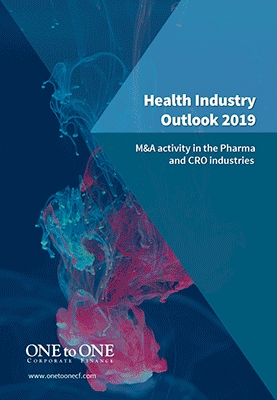Health Industry Outlook 2019: MARÍA JOSÉ MARTÍNEZ, Author and Partner of ONEtoONE | ANTOINE VAN DEN ABEELE, Collaborator and Partner of ONEtoONE | PHILIPPE JANSSENS DE VAREBEKE, Life Science Specialist and Collaborator
M&A activity in the Pharma and CRO industries
 The health industry outlook in 2019 will face multiple important challenges that may significantly transform the overall business landscape. To name some of them: the entry of new competitors from other industries, for instance, several of Amazon’s purchases of licences of pharmaceutical distribution in some states of the US; the entrance of state-of-the-art technology, such as machine learning, smart devices and autonomous robots; changes to legislation that have occurred in the main geographic regions during the last few years; transformations in consumer trends, such as home care, online attention or even telemedicine; or new methods of patient segmentation, which allow customized treatments according to the patients’ specific needs through the knowledge of their medical history.
The health industry outlook in 2019 will face multiple important challenges that may significantly transform the overall business landscape. To name some of them: the entry of new competitors from other industries, for instance, several of Amazon’s purchases of licences of pharmaceutical distribution in some states of the US; the entrance of state-of-the-art technology, such as machine learning, smart devices and autonomous robots; changes to legislation that have occurred in the main geographic regions during the last few years; transformations in consumer trends, such as home care, online attention or even telemedicine; or new methods of patient segmentation, which allow customized treatments according to the patients’ specific needs through the knowledge of their medical history.
However, those challenges have not made a negative impact on the eagerness of investors in the health industry, neither in the M&A activity. As a matter of fact, bigger companies have a better market position owing to technological improvements. As for small and middle-sized companies, they will be forced to incorporate these technologies if they do not want to be left behind.
Pharmaceutical Industry and Contract Research Organisations
On the other hand, the pharmaceutical and health technology industries will not be released of sharp transformations in the following years. The increasingly competitive market, price regulation, expiration of patents, aging of the population, are some of the complex characteristics that define the current situation of these industries. In addition, the need to cope with the rise of globalization, outsourcing, and the complexity of regulation and competition makes it necessary for pharmaceutical companies to have Contract Research Organisations (CROs) as strategic partners.
“Significant mergers & acquisitions have taken place, resulting in the nine major CROs controlling 60% of the market share of clinical trials.
Pharmaceutical laboratories are increasingly delegating competencies to these organisations and it is estimated that the activity of the CROs will continue to grow at an annual rate of 7.4% up to 2020. This growth rate seems to be sustainable and there are indications that this is an increasingly mature market. In fact, significant mergers & acquisitions have taken place, resulting in the nine major CROs controlling 60% of the market share of clinical trials.
M&A activity in the health sector
The number of corporate mergers & acquisitions transactions have remained stable in the entire health industry throughout the years of 2014-2017. Although a large number of transactions were made in the hospital and clinical services sub-sector, the one that received the most investments in 2017 was the pharmaceutical industry, followed by biotechnology and R&D for drugs, medicines, and vaccines.
The main objectives of corporate deals in the health industry have been to achieve or maintain leadership, to increase the presence in each of the health sub-sectors, to take advantage of the R&D capabilities of the acquired companies, and to reduce the costs through the acquisition of HCIT companies. M&A transactions carried out to acquire R&D capabilities in emerging technologies, such as gene therapy and biosimilars have also been common, as well as the acquisition of specialized HCIT software companies to improve efficiency.
However, one of the biggest problems that pharmaceutical companies will face in the future would be the scarce price elasticity of medicines, mostly due to the irruption of new players, such as Amazon, Berkshire Hathaway or JP Morgan Chase. Consequently, pharmaceutical companies are currently focused on the ways of solving out the reduction of total costs of making medicines by:
- The use of Big Data and advanced analyses, in order to develop medical supplies more efficiently.
- The change of focus from widely used medicines to specialized treatments, where companies in the industry have more control over prices.
- The outsourcing of services to CRO so as to develop, manufacture, and commercialize medicines in a more efficient way.
- Contracting Services to HCIT (Healthcare IT) companies to collect and analyze drug development data more efficiently by using digital tools such as modeling and simulation software.
Regarding Private Equity (PE) Investors, they have continued to be active in the health industry, as their circumstances make it an attractive and growing sector. In particular, investors are notably active in the pharmaceutical segments, care for the elderly, the outsourced CRO services, and the hospital industry.
“The transactions of mergers & acquisitions of CROs in 2017 totaled $13.000 million in value. Besides, the growth of the CRO industry is projected to rise another $20.000 million over the next 5 years.
The challenges faced by the pharmaceutical industry, listed above, explain the large volume of acquisitions in the industry. In detail, the transactions of mergers & acquisitions of CROs in 2017 totaled $13.000 million in value. Besides, the growth of the CRO industry is projected to rise another $20.000 million over the next 5 years.
Future prospects
Despite the aforementioned challenges faced by pharma companies, especially the pressure on drug prices, investors are interested in these industries due to their profit margins and the favorable industry situation. This interest is also influenced by the anti-cyclical nature of the health industry in a macro environment, in which the growth rates start to slow down.
Segments, such as brand pharmacy, generics, CRO outsourced services, and biopharmaceutical ICT will continue to arouse interest due to their advantages. Specifically, Clinical Research Organizations provide access to new markets, enhance the reach of clinical trials on demand, allow access to innovative technology, add therapeutic experience, resize structures, and reduce costs.
Finally, with regard to valuations, they are likely to remain high due to the increasing demand for quality health assets, both from Private Equity and corporate buyers, and it is possible to carry out joint purchases between funds and corporate buyers.
The full report “HEALTH SECTOR OUTLOOK 2019” provides more detailed information about the characteristics of the industry and regional M&A activity. In addition, the document offers an overview of the most noteworthy transactions carried out by the leading companies in the sector. Download it here below:



